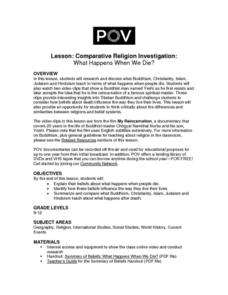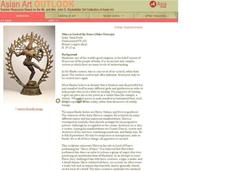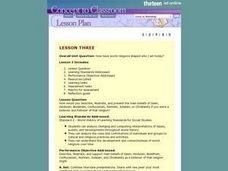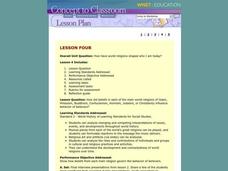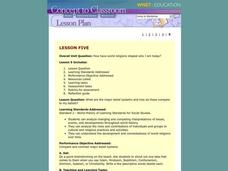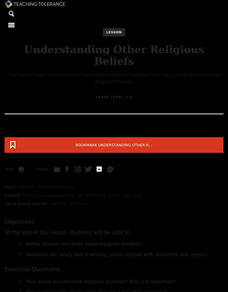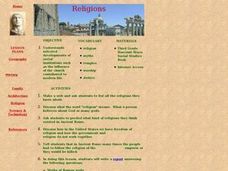American Documentary
Comparative Religion Investigation: What Happens When We Die?
How do different religions offer explanations for what happens when we die? Invite your learners to consider the variance and complexity of religious beliefs, and to research and compare/contrast the concept of death and afterlife...
Curated OER
Angkor What? Angkor Wat!
Students investigate one of the largest religious structures in the world, Angkor Wat, a temple in Cambodia. The temple's place in Southeast Asian history, its history and the migration of ideas of both Hinduism and Buddhism is examined...
Curated OER
Nataraj Shiva as Lord of the Dance
Students considers the piece of artwork entitled, The Nataraj, Lord Shiva and Lord of the Dance to visualize several of the most important ideas of Hinduism.
Curated OER
Lesson Three
Students describe, illustrate, and present main beliefs of Islam, Hinduism, Buddhism, Confucianism, Animism, Judaism, or Christianity religion. They share with a partner their most significant fact about each leader interviewed. Students...
Curated OER
Focus of Native American Religious Practices
Here are five quick lessons you can use to introduce your class to religions from around the world. They view and perform a Native American dance, watch a video on Judaism, compare the difference between Catholics and Protestants, watch...
Curated OER
Global Literature: Nectar In A Sieve
Students write a persuasive essay explaining how religion and/or spirituality serves as both a guide and a source of conflict for both an individual and their culture. They develop a definition for the terms spiritual and religious...
Curated OER
NATARAJ: SHIVA AS LORD OF THE DANCE
Students read" the meaning of the Nataraj, explore the various aspects of Hinduism that the Nataraj symbolizes; examine the importance of the samsara, moksha, and consider the Nataraj one of the finest works of art anywhere in the world.
Curated OER
How have world religions shaped who I am today?
Students analyze changing and competing interpretations of issues, events, and developments throughout world history. They analyze the roles and contributions of individuals and groups in cultural and religious practices and activities.
Curated OER
Social Studies: Religions and Folktales of India
Students examine the world's major religions, focusing on India as presented in folktales. They take notes while reading the stories and retell them orally. Students research belief systems and write one-paragraph reflections about them.
Montana State University
One Mountain, Many Cultures
Americans may think of Mount Everest as a region dedicated to adventurous hikers, but many cultures have flourished there! Learners read informative books, watch videos, participate in classroom discussion, analyze folk tales, and...
Curated OER
How have world religions shaped who I am today?
Students analyze changing and competing interpretations of issues, events, and developments throughout world history. They brainstorm ideas about what they think about Islam, Hinduism, Buddhism, Confucianism, Animism, Judaism, or...
Curated OER
Teaching the Hindu-Buddhist Tradition in East Asian Culture Through Asian Literature and Film
Students explore various intellectual traditions which dominate human history through a variety of contemporary pieces of literature which exemplify the traditions. Biblical monotheism, Greek rationalism, Hinduism, Buddhism, Confucianism...
Contemporary Arts Center
Mughal Miniature Paintings: Pattern Transformations
What is the artist's role in the post 9/11 world? How do artists use imagery to convey meaning in their work? After examining the work of Mughal artist Imran Qureshi, class members create their own work that uses combative imagery to...
Teaching Tolerance
Understanding Other Religious Beliefs
Learn what it means to respect others in an engaging lesson plan on religious beliefs. An inclusive resource focuses on understanding other religious beliefs, the right to freedom of religion, and the U.S. history of religious diversity....
K20 LEARN
Sentence Structure in Siddhartha: Simple, Compound, Complex, and Compound-Complex Sentences
While wisdom may not be communicated, knowledge of sentence structures certainly can. Teach young grammarians the power of syntax with a lesson plan that uses Herman Hesse's Siddhartha as a mentor text. Learners first rewrite captions...
Curated OER
Moral Dilemmas of the Ramayana
Twelfth graders explain the concept of dharma and appreciate differences in moral reasoning. They relate the Ramayana to their own experiences.
Curated OER
Population Diversity in Southeast Asia
Students explore diversity in ethnic, lingual, religious, and political systems of the people of Southeast Asia. The lesson's focus is designed to foster an understanding of the complexity of the region.
Curated OER
The Popular Bully
Fifth graders investigate bullying and nonviolent ways to deal with bullies. In this conflict management instructional activity, 5th graders discover the definition for the word ahimsa and examine ways to incorporate that philosophy...
Curated OER
Creating Nonviolence: A Theatre of the Oppressed Approach to Things Fall Apart
Eleventh graders analyze Ahimsa and complete activities for nonviolence. In this nonviolence lesson, 11th graders define violence and relate it to their lives. Students adapt prose into a dialogue to act out and analyze the violence in...
Curated OER
Religions
Eighth graders explore the major religions of the world. In this religion lesson, 8th graders create a foldable with the characteristics of the religions to study. Students watch videos, PowerPoint slides and look at pictures from the...
Oklahoma Bar Association
Into Which Caste Have You Been Cast?: India's Caste System
What was it like to fit into a certain class with no choice in the matter? Learners experience the caste system in a role-play activity, work individually on handouts to enhance their learning, and participate in an evaluation activity...
Curated OER
LESSON TWO
Students identify major religious leaders and locations. They answer the the question: Who were the religious leaders, where did they live, and what contibutions did they make? Students write their version of the most important...
Curated OER
Australia's Religious Diversity
Students identify major world religions and forms of spirituality and recognise the religious diversity of communities in Australia. They brainstorm for the definition of religion. Students brainstorm to come up with a list of religions.
Curated OER
How Have World Religions Shaped Who I Am Today?
Learners discuss the different religions that make up the world today. They complete an interest inventory about their belief systems and the influence it has had on their lives. In groups of two, then four, then eight they discuss...
Other popular searches
- Hinduism Hindu
- Hinduism and Buddhism
- Hinduism Buddhism
- Hinduism Buddhism Compare
- Hinduism Caste System
- Hinduism Religion
- 4 Goals of Hinduism
- History of Hinduism
- Hinduism Lesson Plan
- Jainism and Hinduism
- Hinduism Naming Ceremony
- Hinduism Karma


